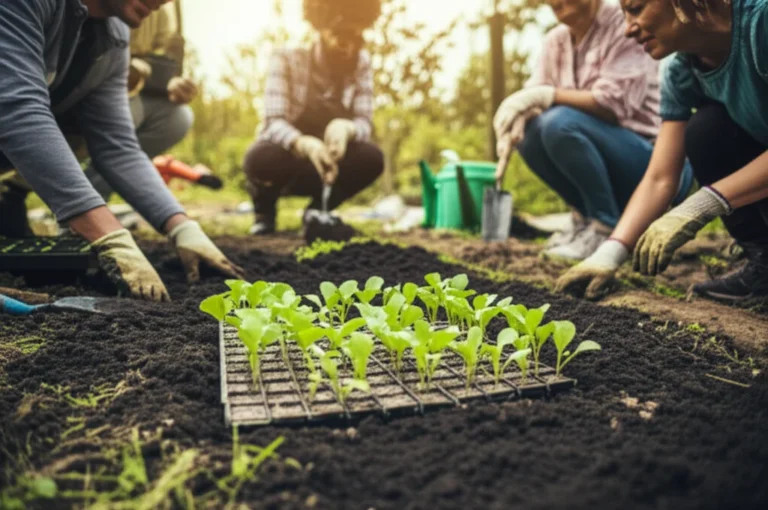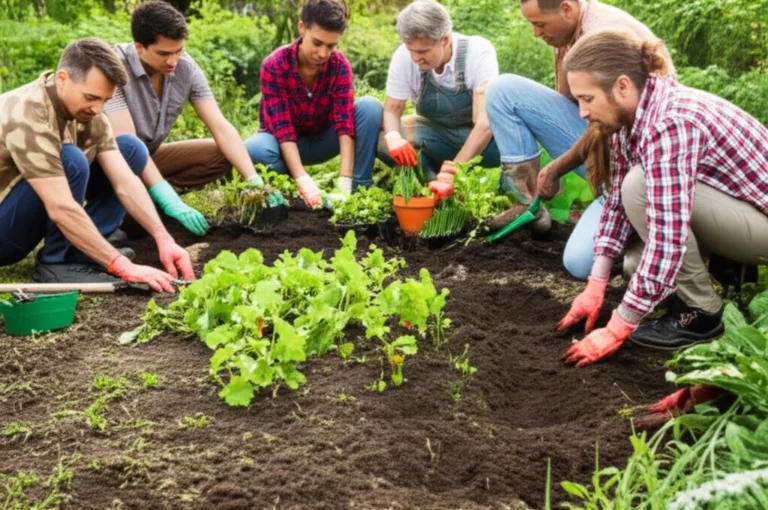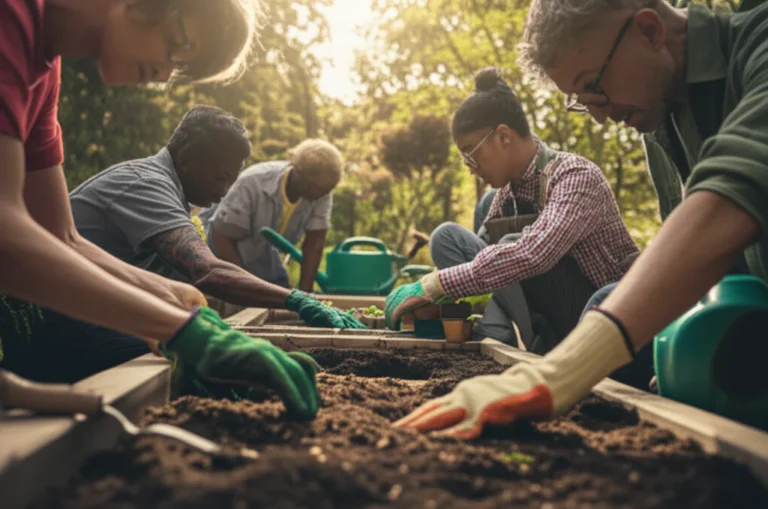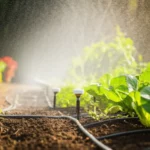Support our educational content for free when you purchase through links on our site. Learn more
Imagine turning an overlooked vacant lot into a buzzing hub of fresh veggies, laughter, and community spirit. Sounds magical, right? But before you plant your first seed, the biggest challenge is often finding the right location—a spot with enough sunlight, good soil, easy access, and community support. Did you know that over 18,000 community gardens thrive across the U.S., each chosen with care to maximize impact? 🌱
In this guide, we’ll walk you through 9 essential steps to scout, evaluate, and secure the perfect community garden location in your area. From decoding zoning laws to testing soil for hidden contaminants, and from rallying neighbors to tapping into local resources, we cover it all. Ready to dig in and discover your garden’s future home? Let’s grow together!
Key Takeaways
- Sunlight and soil quality are non-negotiable: Aim for 6-8 hours of sun and test soil for contaminants or nutrients.
- Accessibility and safety boost participation: Choose spots near transit, with good lighting and visibility.
- Know your local laws: Zoning, permits, and land agreements can make or break your project.
- Community buy-in is crucial: Engage neighbors early to build enthusiasm and shared ownership.
- Leverage public spaces and partnerships: Parks, schools, and nonprofits can be your garden’s best allies.
- Use tech tools: Apps like Sun Seeker and platforms like CommunityGarden.org simplify site scouting.
Ready to start? Grab your soil test kit and check out these top products to get going:
- Rapitest Soil Test Kit: Amazon | Walmart
- Rain Bird Drip Irrigation System: Amazon | Home Depot
Your community garden adventure starts with the right spot—let’s find it together! 🌻
Table of Contents
- Quick Tips and Facts for Finding Your Perfect Community Garden Spot 🌱
- The Roots of Community Gardening: A Brief History & Local Impact 🌿
- 1. How to Scout for Ideal Community Garden Locations: Top Criteria to Consider 🕵️♂️
- 2. Soil Quality and Sunlight: The Dynamic Duo for Thriving Gardens ☀️🌾
- 3. Accessibility and Safety: Making Your Garden Welcoming and Secure 🚶♀️🔒
- 4. Navigating Local Regulations and Zoning Laws for Community Gardens 🏛️📜
- 5. Partnering with Local Organizations and Landowners: Building Garden Allies 🤝🌻
- 6. Utilizing Public Spaces: Parks, Schools, and Vacant Lots as Garden Gems 🏞️🏫
- 7. Environmental Considerations: Water Access, Drainage, and Pollution Risks 💧🌍
- 8. Community Engagement: How to Gauge Neighborhood Interest and Support 🗣️❤️
- 9. Tools and Resources: Using Online Platforms to Find and Map Garden Spaces 🛠️🗺️
- Top Associations and Networks to Connect With: Your Garden’s Best Friends 🌐🌱
- Success Stories: Real-Life Examples of Finding and Flourishing in Community Garden Spots 🌟🌻
- Conclusion: Growing Your Community Garden Dream from the Ground Up 🌼🌍
- Recommended Links for Aspiring Community Gardeners 🔗🌿
- FAQ: Your Burning Questions About Community Garden Locations Answered ❓🌱
- Reference Links and Resources for Deeper Digging 📚🔍
Quick Tips and Facts for Finding Your Perfect Community Garden Spot 🌱
If you’re eager to start your own community garden but wondering how to find the perfect spot, you’re in the right place! At Community Gardening™, we’ve dug into countless gardens and chatted with growers to bring you the essentials:
- ✅ Look for sunny locations with at least 6-8 hours of direct sunlight daily.
- ✅ Check soil quality early—urban soils can be tricky with contaminants or poor nutrients.
- ✅ Accessibility matters! Choose spots near public transit or popular community hubs.
- ✅ Safety first: well-lit, visible, and secure areas keep gardeners coming back happily.
- ✅ Know your local zoning laws and get permissions before planting a single seed.
- ✅ Engage your neighbors early to build support and avoid conflicts.
- ✅ Start small and grow organically—sometimes the best gardens begin with a single plot.
For a deeper dive into starting your garden, check out our detailed guide on How do I start a small community garden?.
Want the full scoop on each of these? Keep reading—we’re about to turn over every stone! 🌿
The Roots of Community Gardening: A Brief History & Local Impact 🌿
Community gardens are more than just patches of dirt—they’re living legacies of resilience, culture, and connection. From victory gardens during wartime to urban farms revitalizing neighborhoods, these green spaces have always been about growing together.
- In the U.S., community gardening surged during the Great Depression and WWII, providing food security and hope.
- Today, gardens serve as social hubs, educational platforms, and environmental sanctuaries in cities.
- According to the American Community Gardening Association, over 18,000 community gardens exist nationwide, each with unique stories and challenges.
- Gardens often reflect the cultural heritage of their neighborhoods, fostering diversity and inclusion.
Understanding this history helps you appreciate the power of place when choosing your garden site. It’s not just about dirt—it’s about people, stories, and shared growth.
1. How to Scout for Ideal Community Garden Locations: Top Criteria to Consider 🕵️♂️
Before you grab your trowel, scouting is key! Here’s how to become a garden detective:
Step 1: Identify Potential Sites
- Vacant lots, schoolyards, parks, church grounds, and rooftops are prime candidates.
- Use tools like CommunityGarden.org’s Map to see existing gardens and open spaces nearby.
- Check with your city’s Parks and Recreation or Cooperative Extension offices for available land.
Step 2: Evaluate Location Factors
- Sunlight: Minimum 6 hours/day of direct sun.
- Size: Enough space for plots, pathways, and communal areas.
- Water Access: Nearby spigots or rainwater collection potential.
- Soil Condition: Test for contaminants (lead, petroleum) via local extension services.
- Accessibility: Close to public transport, parking, and wheelchair-friendly paths.
- Safety: Well-lit, visible, and low crime areas.
Step 3: Community Fit
- Is the site near your target community?
- Does it align with neighborhood needs (food deserts, social spaces)?
- Are neighbors supportive or at least neutral?
By ticking these boxes, you’ll find a spot that’s not just suitable but thrives with community love.
2. Soil Quality and Sunlight: The Dynamic Duo for Thriving Gardens ☀️🌾
Nothing beats good soil and sunshine for a flourishing garden. Here’s what we’ve learned:
Soil Testing: Your Garden’s Health Check
- Urban soils often contain heavy metals or chemicals. Testing kits from brands like Rapitest or services from your local Cooperative Extension can reveal nutrient levels and contaminants.
- If soil is poor or contaminated, consider raised beds with imported organic soil or BioBag compost bags.
- Amend soil with organic matter like compost, manure, or leaf mold to boost fertility.
Sunlight: The Energy Source
- Most vegetables and flowers need 6-8 hours of direct sun.
- Use a simple sunlight meter app or observe shadows throughout the day.
- Avoid shaded areas under large trees or buildings.
Quick Soil & Sunlight Checklist
| Factor | Ideal Condition | How to Test/Check |
|---|---|---|
| Soil pH | 6.0 – 7.0 (slightly acidic to neutral) | Soil test kits or extension services |
| Contaminants | Below EPA limits for lead, arsenic | Professional soil testing |
| Sunlight Hours | 6-8 hours direct sunlight | Observe or use sunlight meter apps |
| Drainage | Well-drained, no standing water | Dig test holes, observe after rain |
With these in hand, your garden will be set for success. For more on soil and plant choices, see our Edible Plants category.
3. Accessibility and Safety: Making Your Garden Welcoming and Secure 🚶♀️🔒
A garden that’s hard to reach or feels unsafe won’t flourish. Here’s how to keep your spot friendly and secure:
Accessibility Tips
- Choose locations near bus stops, bike lanes, or pedestrian paths.
- Ensure pathways are wheelchair accessible with smooth, firm surfaces.
- Provide nearby parking for those who drive.
Safety Essentials
- Good lighting deters vandalism and makes evening events possible.
- Visibility from streets or homes increases security.
- Fencing can protect plants but avoid making the garden feel closed off.
- Collaborate with local police or neighborhood watch groups for extra eyes.
Remember, a welcoming garden is a community magnet—the more open and safe, the more hands to help!
4. Navigating Local Regulations and Zoning Laws for Community Gardens 🏛️📜
Before planting a single seed, you’ll want to know the legal landscape:
Key Legal Considerations
- Zoning: Check if the land is zoned for agricultural or community use. Some cities have special designations for urban gardens.
- Permits: You might need a permit from your city or county. Some places require liability insurance.
- Land Use Agreements: For private or public land, get written permission or lease agreements.
- Water Use Regulations: Some municipalities regulate outdoor water use.
How to Navigate
- Contact your city’s Planning or Parks Department.
- Reach out to local Cooperative Extension offices for guidance.
- Consult community garden coalitions or nonprofits like the American Community Gardening Association.
Understanding these rules upfront saves headaches later and helps build community trust.
5. Partnering with Local Organizations and Landowners: Building Garden Allies 🤝🌻
Community gardens thrive on partnerships. Here’s how to build your garden’s dream team:
Potential Partners
- Local government agencies: Parks, schools, housing authorities.
- Nonprofits: Food banks, environmental groups, urban agriculture networks.
- Faith-based organizations: Churches often have unused land.
- Businesses: Nurseries or hardware stores might donate supplies.
- Neighbors: Engage residents early for support and stewardship.
Tips for Successful Partnerships
- Present a clear vision and benefits for all parties.
- Offer to maintain the site and handle liability concerns.
- Be open to feedback and adapt plans accordingly.
Our friends at CommunityGarden.org emphasize that “building relationships is as important as building beds.” We couldn’t agree more!
6. Utilizing Public Spaces: Parks, Schools, and Vacant Lots as Garden Gems 🏞️🏫
Public spaces can be gold mines for community gardens if you know how to approach them:
Parks
- Often underused areas can be transformed into garden plots or pollinator habitats.
- Coordinate with Parks Departments for permissions and maintenance plans.
Schools
- Schoolyards offer educational opportunities and secure land.
- Partner with teachers and PTA groups to integrate gardening into curricula.
Vacant Lots
- Cities sometimes lease or sell vacant lots cheaply or even for free to community groups.
- Minneapolis’s example of renting tornado-damaged lots for $1/year is legendary!
- Start small and expand as community interest grows.
Remember, these spaces often come with rules and responsibilities, so clear communication is key.
7. Environmental Considerations: Water Access, Drainage, and Pollution Risks 💧🌍
Your garden’s environment can make or break your harvest. Here’s what to watch:
Water Access
- Reliable water sources are essential—look for spigots or consider rainwater harvesting systems.
- Drip irrigation systems like Rain Bird or Orbit can conserve water and improve efficiency.
Drainage
- Avoid flood-prone areas or spots with standing water after rain.
- Raised beds or mounded rows can improve drainage.
Pollution Risks
- Urban sites may have soil contamination from past industrial use or traffic.
- Test soil for heavy metals and hydrocarbons.
- If contamination exists, use raised beds with clean soil or container gardening.
Taking these steps ensures your garden is healthy, safe, and sustainable.
8. Community Engagement: How to Gauge Neighborhood Interest and Support 🗣️❤️
A garden without gardeners is just dirt! Here’s how to grow community enthusiasm:
Strategies to Engage
- Host informal meetups or info sessions at local libraries or cafes.
- Use social media groups or neighborhood apps like Nextdoor.
- Distribute flyers and door hangers in the neighborhood.
- Partner with local schools, churches, and businesses to spread the word.
Listening is Key
- Ask neighbors what they want to grow or see in the garden.
- Address concerns about noise, parking, or aesthetics early.
- Create a shared vision and garden rules collaboratively.
As one gardener shared with us, “The garden became a neighborhood heartbeat once everyone felt they had a stake in it.” That’s the magic of community!
9. Tools and Resources: Using Online Platforms to Find and Map Garden Spaces 🛠️🗺️
Technology can be your best garden buddy when scouting locations:
Useful Platforms
- CommunityGarden.org’s Garden Map: Find existing gardens and open spaces near you.
- Google Earth/Maps: Explore vacant lots, sunlight patterns, and accessibility.
- Local government GIS portals: Many cities provide detailed land use maps online.
- Facebook Groups & Nextdoor: Connect with local gardeners and find informal garden spaces.
Apps for Garden Planning
- Sun Seeker: Tracks sun paths to help find sunny spots.
- Garden Planner by GrowVeg: Visualize your garden layout before digging.
Using these tools saves time and helps you make informed decisions.
Top Associations and Networks to Connect With: Your Garden’s Best Friends 🌐🌱
Joining forces with established groups can boost your garden’s success:
| Organization | What They Offer | Website |
|---|---|---|
| American Community Gardening Association (ACGA) | Resources, advocacy, and network connections | communitygarden.org |
| Local Cooperative Extension Offices | Soil testing, workshops, and technical advice | Varies by state |
| Urban Agriculture Networks | Peer support, seed exchanges, and event info | Search locally or regionally |
| Food Policy Councils | Help with zoning, funding, and policy navigation | Varies by city |
These allies provide expertise, funding leads, and community connections that can transform your garden from a dream to reality.
Success Stories: Real-Life Examples of Finding and Flourishing in Community Garden Spots 🌟🌻
Nothing inspires like stories from the dirt! Here are a few gems:
- Minneapolis Tornado Lots: After a devastating tornado, neighbors turned empty lots into thriving gardens, renting land for just $1/year. They started small, built community events, and now have a buzzing hub of green and friendship.
- Philadelphia Urban Farms: Immigrant and refugee communities transformed vacant lots into culturally rich gardens, growing traditional crops and sharing harvests with neighbors.
- Denver’s DUG Network: The Denver Urban Gardens network helped gardeners find spaces, navigate permits, and build community through workshops and seed swaps.
These stories remind us: start small, listen to your community, and let the garden grow naturally.
Conclusion: Growing Your Community Garden Dream from the Ground Up 🌼🌍
So, you’ve journeyed through the dirt and details of finding the perfect spot for your community garden—from scouting sunny, safe locations to navigating zoning laws and rallying your neighbors. At Community Gardening™, we’ve seen time and again that the best gardens grow from a blend of careful planning, community spirit, and a willingness to start small and adapt.
Remember the wisdom from Minneapolis’s tornado-lot gardeners: “Just begin. Get in the dirt and let it tell you what it needs.” That’s the secret sauce. No perfect spot exists—only the one you nurture with care, collaboration, and patience.
By combining solid research (soil tests, sunlight checks), legal savvy (permits, agreements), and heartfelt community engagement, you’ll cultivate not just plants, but friendships, resilience, and local pride. So grab your gloves, gather your neighbors, and get ready to grow something truly special. Your community garden awaits! 🌻
Recommended Links for Aspiring Community Gardeners 🔗🌿
Ready to gear up and dig in? Here are some top tools and resources to help your garden thrive:
- Rapitest Soil Test Kit:
- BioBag Organic Compost Bags:
- Rain Bird Drip Irrigation System:
- 👉 Shop on: Amazon | Home Depot
- Sun Seeker App:
- Available on Apple App Store | Google Play
- Garden Planner by GrowVeg:
- Visit GrowVeg Official Site
Books to Grow Your Knowledge:
- The Community Garden Handbook by Ben Raskin — Amazon
- Urban Gardening: How to Grow Food in the City by David Tracey — Amazon
- The American Community Gardening Association’s Guide — ACGA Website
FAQ: Your Burning Questions About Community Garden Locations Answered ❓🌱
What are the key factors to consider when choosing a location for a community garden?
Choosing the right location means balancing sunlight, soil quality, accessibility, safety, and legal permissions. The site should receive at least 6-8 hours of direct sunlight daily, have soil free from contaminants (or be suitable for raised beds), and be easily accessible by public transit or walking. Safety includes good lighting and visibility to deter vandalism. Finally, check local zoning laws and obtain necessary permits or agreements to avoid future headaches.
How can I assess the sunlight and soil quality of a potential community garden site?
For sunlight, observe the site throughout the day or use apps like Sun Seeker to track sun exposure. Aim for 6-8 hours of direct sunlight for most vegetables and flowers. For soil, use a soil test kit (e.g., Rapitest) or contact your local Cooperative Extension for professional analysis. Testing reveals pH, nutrient levels, and contaminants like lead or petroleum residues. If soil is poor or contaminated, raised beds with clean soil are a smart alternative.
What are the benefits of starting a community garden in an urban area, and how can I get started?
Urban community gardens provide fresh food access, green space, social connection, and environmental benefits like improved air quality and stormwater management. They can revitalize neighborhoods and foster cultural exchange. To get started, identify a suitable location, engage your community, navigate local regulations, and build partnerships with organizations or landowners. Starting small and growing organically, as seen in Minneapolis and Philadelphia, is a proven recipe for success.
How can I engage with my local community and gather support for a new community garden project?
Start by hosting informal meetings or info sessions to listen and share your vision. Use social media platforms like Nextdoor or Facebook groups to spread the word. Collaborate with schools, churches, and local businesses to widen your reach. Address concerns transparently and invite neighbors to participate in planning and decision-making. Creating shared garden rules and community events fosters ownership and long-term commitment.
How do I navigate local regulations and zoning laws for community gardens?
Begin by contacting your city’s Planning or Parks Department to understand zoning designations and permit requirements. Some cities have special urban agriculture zones or community garden policies. You may need liability insurance or formal land use agreements, especially on public or private land. Local Cooperative Extension offices and organizations like the American Community Gardening Association can provide guidance and model policies.
What are some creative ways to utilize limited or unconventional spaces for community gardening?
If traditional plots are scarce, consider raised beds on rooftops, vertical gardens on fences or walls, container gardening on balconies, or transforming boulevards and medians into pollinator-friendly habitats. Partner with schools or businesses for shared spaces. Urban farms and guerrilla gardening (planting in neglected public spaces) are also options, though the latter requires careful legal consideration.
Reference Links and Resources for Deeper Digging 📚🔍
- American Community Gardening Association (ACGA) — communitygarden.org
- Community Garden Locator Map — communitygarden.org/garden
- Cooperative Extension Services Directory — nifa.usda.gov/extension
- Minneapolis Tornado Lot Gardens Case Study — hopefulneighborhood.org/blog/the-power-of-community-gardens
- Urban Agriculture Networks and Resources — usda.gov/urban-agriculture
- Soil Testing and Safety Guidelines — epa.gov/urban-agriculture
- Sun Seeker App — sunseekerapp.com
- GrowVeg Garden Planner — growveg.com
For more inspiration and community stories, check out The Power of Community Gardens – The Hopeful Neighborhood.





